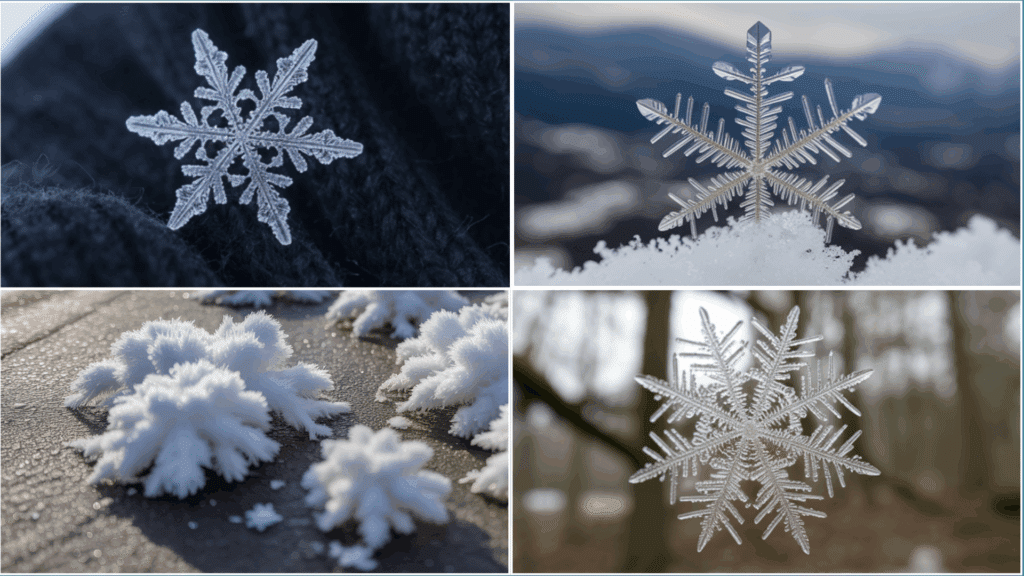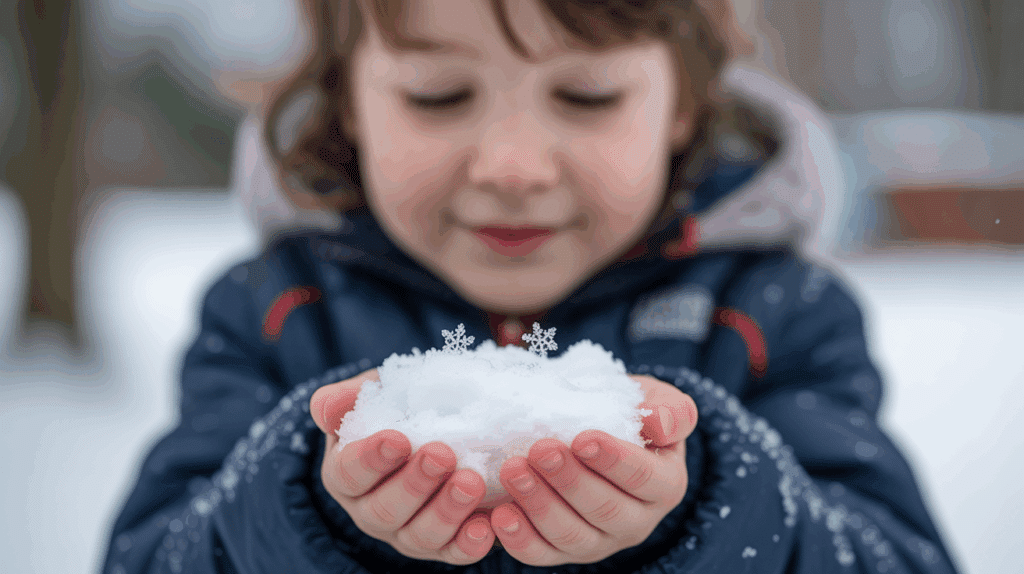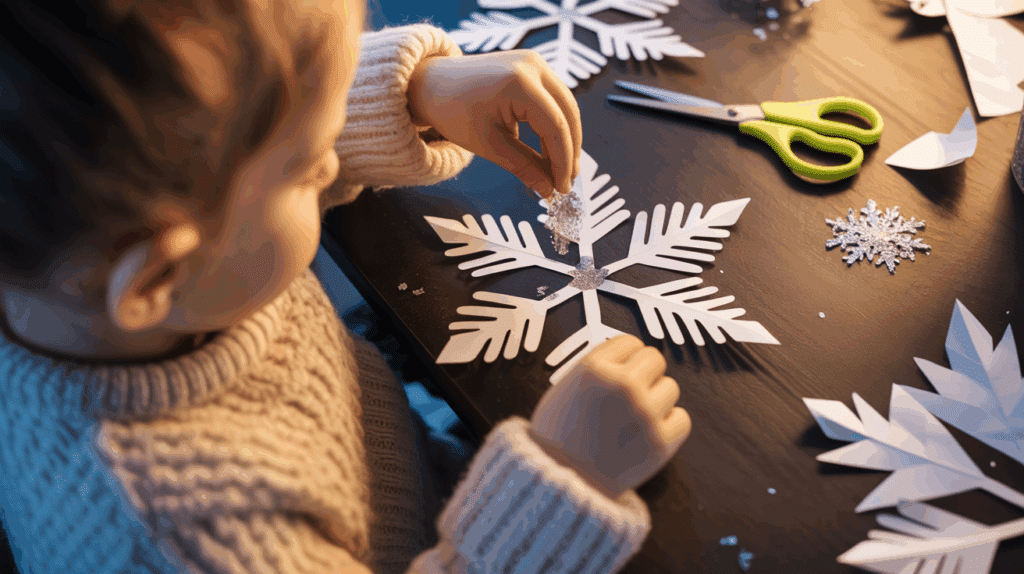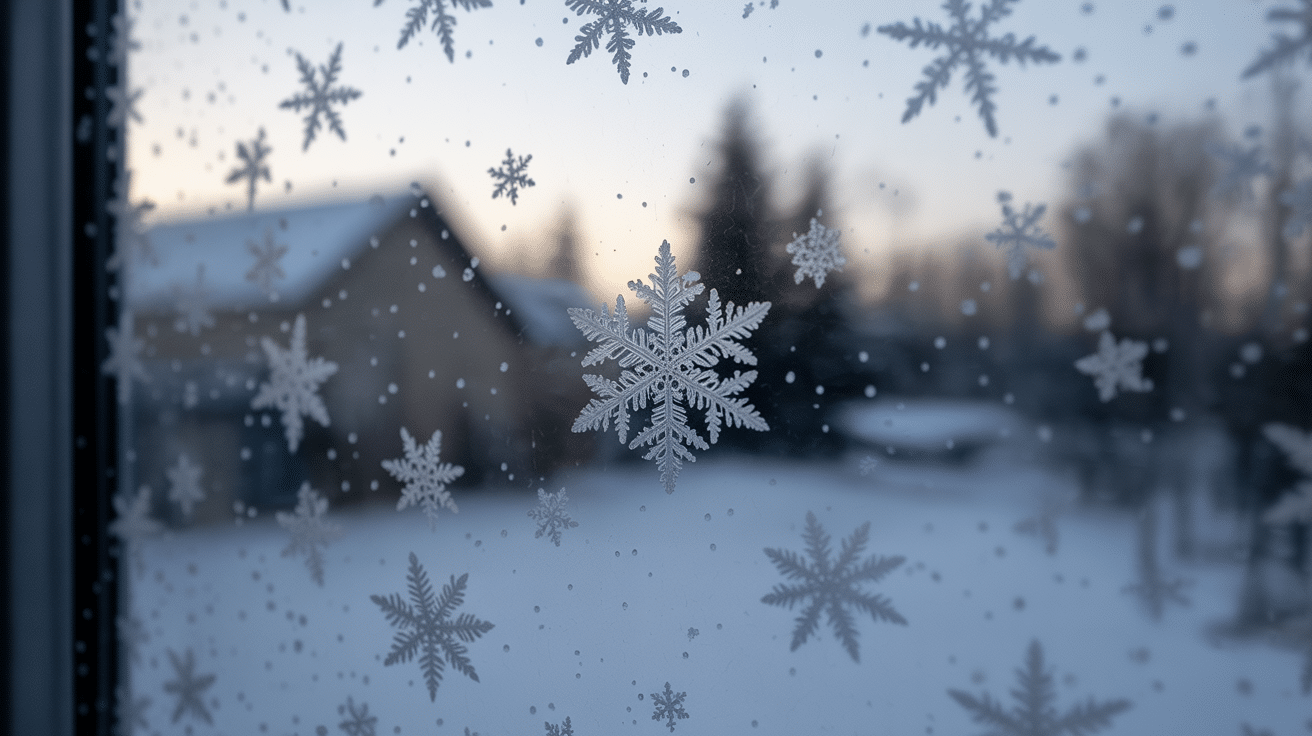Snow falls softly; kids often feel left out when science seems too hard to understand or boring. But snow is anything but boring!
This blog post shares fun snowflake facts that will make you the smartest kid in class.
You’ll learn about different types of snowflakes, cool science behind how they form, surprising snowflake facts for kids, and snow activities you can try at home.
Get ready to become a snow expert with facts your friends won’t know!
What is a Snowflake: Science Explained
A snowflake is a small piece of ice that forms in clouds and falls to the ground. Each snowflake starts as a tiny water droplet that freezes.
Snowflakes form when water vapor in clouds gets cold enough to freeze.
This happens at temperatures below 0°C (32°F). As the water vapor freezes, it creates ice crystals. These crystals grow larger as more water vapor freezes onto them.
Snowflakes fall from the sky because of gravity. When the ice crystals in clouds get heavy enough, they can’t stay up in the air anymore. The wind and air currents affect how snowflakes move as they fall. Sometimes they join together to make bigger flakes.
Different Types of Snowflakes and Snow

Snow might look the same at first glance, but there are many types of snowflakes and snow. Each type forms under specific weather conditions.
The type of snow affects how it looks, feels, and even sounds when you walk on it.
- Star-shaped crystals form in light clouds with low moisture. They have six points and look like the stars we draw.
- Plate crystals are flat, six-sided shapes that form when it’s not too cold. They often catch light and sparkle.
- Column crystals look like tiny sticks or pencils. They form in colder air than plates.
- Needle crystals are thin and long. They usually form when temperatures are just below freezing.
- Capped columns have plates on both ends of a column, like a tiny spool.
- Dendrites have branches coming off their six main arms. These are the classic “snowflake” shapes we often see in pictures.
- Rime forms when water droplets freeze onto crystals, making them look fuzzy.
Amazing Snowflake Facts for Kids

Snowflakes are made from ice crystals that form in clouds when water vapor freezes. As the crystals grow, they form different shapes depending on the temperature and humidity in the air.
Every snowflake starts as a tiny dust particle. Water vapor sticks to it and freezes, beginning the process of creating a beautiful snowflake with a unique shape.
Even though snowflakes look white, the ice crystals are actually clear. The white color comes from light bouncing off the snowflake’s many surfaces.
No two snowflakes are exactly alike. Their shapes change based on the conditions in the cloud and the air they pass through as they fall to the ground.
If the weather conditions are just right, snowflakes can grow very large. Some have been recorded as being more than two inches wide.
Scientists study snowflakes using microscopes to see their detailed shapes. This branch of science is called crystallography.
Snowflakes form in clouds when the temperature is below freezing and there is enough moisture in the air. Not all clouds can make snowflakes.
Some snowflakes form long, thin needle shapes, while others look like stars or tiny plates. The shape depends on the temperature and humidity when they form.
Snowflakes fall at different speeds. A typical snowflake may drift down at about 1 mile per hour, but some can fall faster or slower depending on their shape and size.
The biggest snowflake ever recorded was said to be 15 inches wide and 8 inches thick. It reportedly fell in Montana in 1887, though it hasn’t been proven.
Snowflakes are symmetrical, which means their arms match. Each snowflake has six matching arms, making it look like a tiny icy star.
When it’s very cold and dry, snowflakes tend to be small and simple. Warmer and wetter air helps create more complex and beautiful shapes.
The study of snow and ice is known as snow science or nivology. It helps meteorologists understand weather, climate, and even avalanches.
Snowflakes can melt if they fall through a layer of warmer air. If they refreeze before reaching the ground, they become sleet.
A snowflake’s path from cloud to ground may take several minutes. During that time, it can change shape as it travels through different air layers.
Some snowflakes are so light and fluffy that they can float on air for a long time, while others are dense and fall quickly to the ground.
Snowflakes are a part of the water cycle. They begin as water vapor in clouds, freeze into crystals, fall as snow, and later melt back into water.
Snowflakes help scientists study weather patterns and climate. By analyzing snow layers, scientists can learn about past winters and how the climate is changing.
Snowflakes need very cold temperatures to form, usually below 32°F (0°C). If it’s warmer than that, the snow may turn into rain before reaching the ground.
Some snowflakes are so delicate that they can break apart before they even hit the ground. Wind, temperature, and humidity all affect their strength and shape.
Snowflakes can clump together as they fall, creating the big, fluffy snowflakes we sometimes see during heavy snowfall.
Snowflakes help keep Earth cool. When snow covers the ground, it reflects sunlight back into space, helping lower temperatures and slow down melting.
The way snowflakes stick together on the ground can affect how easy or hard it is to shovel snow. Light snow is easier to move than wet, heavy snow.
Animals like polar bears and arctic foxes use snow for camouflage and shelter. Snowflakes help build the snowy environment these animals rely on to survive.
Each snowflake starts forming high in the sky and changes shape as it falls. That’s why it’s almost impossible for two snowflakes to be identical.
Scientists use snowflakes to learn more about storms and snow formation. They even send instruments into clouds to study snow crystal growth.
There’s a classification system with over 35 types of snowflake shapes. This system helps scientists describe and understand the different patterns snowflakes can form.
When people talk about “dry snow” or “wet snow,” they’re referring to how much water is in the flakes. Wet snow is heavier and great for snowballs!
The shape of a snowflake comes from how hydrogen and oxygen atoms bond in frozen water. It’s a natural example of beautiful, balanced chemistry.
High-speed cameras can take photos of snowflakes in midair. These pictures show how detailed and different each one is.
Wilson Bentley was one of the first people to photograph snowflakes. He spent years capturing their shapes and showed the world how complex they are.
Snowflakes can form at the top of very tall clouds, sometimes several miles high. The colder the cloud, the faster the crystals grow.
The smallest snowflakes are called “diamond dust.” These tiny ice crystals sparkle in the air and are usually seen on very cold, clear days.
Even though snowflakes fall from the sky, they can bounce when they hit hard surfaces, especially if the surface is icy or frozen.
Snowflakes don’t always fall straight down. Wind can carry them sideways, making them spin and tumble as they drift to the ground.
Snowflakes are a part of the water cycle. They begin as water vapor in clouds, freeze into crystals, and fall as snow. When they melt, snowflakes help fill rivers and lakes, and snowmelt provides water for drinking, farming, and power generation.
The snowflake’s shape can affect how it sounds when you walk on it. Powdery snow crunches less than icy, hard-packed snow.
Snowflakes are fragile. Even your warm breath or the heat from your hands can melt them instantly.
Snowflakes don’t only fall in cold places. They can fall almost anywhere in the world if the weather gets cold enough for long enough.
When millions of snowflakes fall together, they create snowdrifts. Wind helps push snow into hills and banks that can be several feet high.
Artists and designers often use snowflake shapes in patterns because of their symmetry and beauty. Snowflakes inspire holiday decorations, fabrics, and even jewelry.
It’s possible to make snowflakes in a lab. Scientists freeze water vapor under controlled conditions to grow artificial snowflakes for study.
In some cultures, snowflakes represent purity, peace, and renewal. Their clean, white appearance often symbolizes a fresh start or a new season.
Every winter, some parts of Earth get buried under several feet of snow. That snow starts out as billions of individual snowflakes coming together.
Snowflakes grow faster in clouds filled with supercooled water droplets, which are water drops that stay liquid even below freezing.
Ice crystals that form snowflakes can also grow on airplanes and cars during freezing conditions, making snowflake science important for travel safety.
Some people collect snowflakes by catching them on cold black paper or glass. This allows them to view the crystals before they melt.
When snowflakes pile up, they create insulation that keeps the ground below warmer than the air above. This helps some animals stay warm under the snow.
Depending on how light and fluffy the snow is, a single inch might contain over a million snowflakes.
In nature, snowflakes don’t fall one at a time. They fall in huge numbers, creating the soft, quiet sound of snowfall.
A magnifying glass helps you see snowflakes better, spotting their tiny details before they melt.
Cold weather isn’t enough to create snow. The air also needs the right amount of moisture for snowflakes to form.
Some snowflakes fall from clouds and evaporate before reaching the ground. This is called “virga” and looks like streaks of snow in the sky.
Snowflakes can pile up in layers. Each layer tells a story about the weather at the time it fell, kind of like tree rings.
Snowflakes in Antarctica may take longer to fall because the air is dry and cold, causing them to float down very slowly.
Some winter sports depend on the shape and texture of snowflakes. Skiers and snowboarders prefer fresh powder made of new, fluffy flakes.
Snowflakes are a big part of winter holidays around the world. People use them in crafts, greeting cards, and light displays.
Not all snowflakes are flat. Some grow into long columns or tubes if the conditions in the clouds are just right.
Snowflakes melt faster when the air is humid. That’s why snowy days can quickly turn slushy if the weather changes.
Fun Snowflake Crafts & Experiments for Kids

Winter brings the perfect chance to enjoy snow-themed crafts. Try these five easy activities that bring the magic of snowflakes indoors, even on warm days.
- Paper Snowflakes: Fold a square paper into triangles, snip small shapes along the edges, then unfold to reveal a unique design. Every cut creates a different pattern. Add a bit of glitter for extra shine.
- Cotton Ball Snow Scene: Glue cotton balls on blue paper to create a puffy winter landscape. The soft texture feels like touching clouds! This project works well for all ages and makes a cozy winter scene for bedroom walls.
- Snowflake Window Clings: Use white school glue to draw snowflake patterns on wax paper. Let dry completely overnight until clear. Carefully peel off and stick to windows for pretty ice-like decorations that catch sunlight. Add a drop of food coloring or sprinkle glitter into the wet glue for colorful winter designs.
- Instant Snow with Baking Soda: Mix 2 cups of baking soda with shaving cream in a bowl until it is cold and crumbly. This fake snow is chilly to the touch and can be molded into shapes. This sensory play activity is perfect for days when real snow isn’t available.
The Final Flake
In this blog, we’ve learned about some cool snowflake facts for kids, from how they form high in clouds to why each one has six sides.
So, the next time snow falls, grab a dark piece of paper and catch a few flakes. Take a close look with a magnifying glass before they melt away.
Which snowflake fact surprised you the most? Try making paper snowflakes and share your creations with us in the comments!




